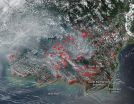(Press-News.org) A new drug, anamorelin, improves appetite and body mass in patients with advanced lung cancer who are suffering cancer anorexia and cachexia, according to phase III data presented at the ESMO 2014 Congress in Madrid, Spain.
"Anorexia and cachexia are among the most troubling and distressing symptoms of advanced cancer, for both patients and their families," says the study's principal investigator, Dr Jennifer Temel from the Department of Medicine, Massachusetts General Hospital, Boston, USA.
Symptoms of the wasting syndrome can include a loss of weight and muscles, together with fatigue, weakness, and loss of appetite. The condition is very common in patients with advanced lung cancer. Anamorelin aims to address the symptoms by mimicking the effects of the so-called "hunger hormone" ghrelin, which is secreted by the stomach.
The large, randomized controlled ROMANA 1 and 2 trials are the first phase III studies examining the impact of anamorelin on anorexia-cachexia in patients with advanced lung cancer.
In the ROMANA studies, patients with unresectable stage III or IV non-small cell lung cancer with cachexia were randomized to receive either 100 mg anamorelin or placebo, given orally each day for 12 weeks.
Among 484 participants in ROMANA 1, those taking anamorelin experienced a median increase in lean body mass of 1.10 kg in 12 weeks, compared to a loss of 0.44 kg for those taking placebo. Body weight increased in the anamorelin arm by an average of 2.2 kg, compared to 0.14 kg in the placebo arm of the study. Patient symptoms or concerns regarding anorexia-cachexia, including appetite, also significantly improved over 12 weeks in patients taking anamorelin. The most frequent drug-related adverse events included hyperglycemia and nausea.
In ROMANA 2, 495 participants with advanced non-small cell lung cancer experiened similar benefits. Body weight increased by 0.95 kg on average, compared to a loss of 0.57 kg for those receiving placebo, and patient symptoms/concerns regarding anorexia-cachexia significantly improved over 12 weeks.
Patients receiving anamorelin did not experience improvements in their muscle strength, as measured by hand grip strength, although Temel notes that particular test can be difficult to administer in this patient population.
In summary, she says: "Having a safe and well tolerated drug in our armamentarium to improve the incredibly troubling symptoms of anorexia and cachexia will have a dramatic impact on both patients and their families."
Commenting on the results, Associate Professor Florian Strasser from Cantonal Hospital St.Gallen, Switzerland, Chair of the ESMO Palliative Care Working Group, said the results of the Romana trials are promising. "These studies are paving the way towards a multi-component and most likely also a multi-modal treatment for patients suffering from Cancer Anorexia-Cachexia Syndrome."
Cancer anorexia-cachexia syndrome is characterized by four interacting components: loss of muscle mass, decreased nutritional intake, metabolic and inflammatory alterations driven by active cancer disease, and decreased physical and psychosocial function, Strasser explained. Patients and their family members experience symptoms and concerns associated with each domain such as weakness, loss of appetite, early satiety, taste problems, fatigue or eating-related distress.
"Current management includes nutritional counseling, resistance training and increase of physical activity, psychosocial support and multimodal symptom control. However, these interventions are limited in their effect, and no pharmacological treatment is available to address the relevant components of the syndrome. In addition to quality of life of patients and family members, it has an impact on anticancer treatment efficacy and toxicity as well as survival."
"Both the Romana I and II trials report an improvement of both muscle mass and patients' symptoms and concerns while minimal and manageable side effects occur," Strasser said.
"This is the first anti-cachexia drug for which reports from two placebo-controlled, double blind phase III trials show a consistent effect on different components of the cancer anorexia-cachexia syndrome," Strasser said. "Further data are needed to show whether the increase of muscle mass is accompanied by a gain of fat mass, which would confirm that patients can build reserves while having more appetite. This would be a novel finding: a drug stimulating appetite resulting in more muscle mass and increasing reserves."
Strasser noted that the lack of effect of the drug on hand-grip strength (HGS) as reported in the trial requires further explanation. "HGS measures only upper but not lower extremity strength, and it does not inform enough about physical function and daily living. The populations studied are relatively young and in a good performance status, without information on multimodal management, namely reversible secondary nutrition impact symptoms. Further data need therefore to show whether the improved symptoms and concerns are related to the known mechanism of the oral ghrelin agonist."
Since both effective anticancer treatment as well as state-of-the-art early integrated palliative medicine with multimodal interventions can improve the cancer anorexia-cachexia syndrome and modify the effects of anti-cachexia drugs, such information is needed to better understand the results, he said.
"Do these trials already show a true clinical benefit, the clinical effectiveness, in a real world population? Probably not yet. The data are promising since the outcomes reported cover more than one relevant component of the CACS and are related to each other. Anamorelin responds to a yet unmet frequent clinical need having an impact on both the patient and the tumour control outcomes with minimal risk," Strasser said.
INFORMATION: END
Anamorelin improve appetite and body mass in patients with cancer anorexia-cachexia
Phase III trial indicates the drug is safe and well tolerated in advanced non-small cell lung cancer
2014-09-27
ELSE PRESS RELEASES FROM THIS DATE:
Afatinib improves progression-free survival in head and neck cancer
2014-09-27
The tyrosine kinase inhibitor afatinib significantly improved progression-free survival compared to methotrexate in patients with recurrent or metastatic squamous cell carcinoma of the head and neck after failure of platinum-based chemotherapy, the results of a phase III trial show.
Presented at the ESMO 2014 Congress in Madrid, the Lux-Head & Neck 1 trial showed that patients who received treatment with 40 mg/day oral afatinib had a 20% reduction in risk of progression or death compared to patients who received methotrexate, with a median progression-free survival of ...
Rolapitant reduces nausea and vomiting in Phase III trial
2014-09-27
Rolapitant reduces nausea and vomiting in patients receiving cisplatin-based chemotherapy, according to the results of a phase III trial presented for the first time today at the ESMO 2014 Congress in Madrid, Spain.
Dr Martin Chasen, lead author and medical director, Palliative Care, Ottawa Hospital Cancer Centre, Canada, said: "This agent makes a significant difference in the way people tolerate their chemotherapy. Patients experienced no loss in quality of life and, in fact, many saw meaningful improvements. One of the patients in the rolapitant cohort reported that ...
Countries must work together to stop organ traffickers, says researcher
2014-09-27
The author of new research into organ trafficking has called for a concerted international effort to confront the problem.
Dr Ana Manzano, of the School of Sociology and Social Policy at the University of Leeds, says a combination of factors means nobody knows definitively how many organs are being traded across the world.
She said: "Unless these issues are addressed and countries work together to take firm action against the traffickers, more people who have their organs trafficked will die.
"Even in the UK, although the World Health Organization has identified us ...
Smoke still rising from King Fire in California
2014-09-26
Over 96,004 acres have been burned by the King Fire since it began on September 13, 2014. The fire is currently 68% contained, and the cause of the fire is arson. Just a few days ago, (Sept. 23) the fire was only 38% contained so progress on extinguishing it continues. Over 7,700 personnel are battling this fire.
A Pacific system came through the fire area yesterday (9/25) bringing 0.6-0.9 inches of rain. The observed fire activity was minimal with smoldering in interior pockets of the heavier fuels. A low pressure system will become the dominate feature today (9/26) ...
Agricultural fires blaze in Borneo
2014-09-26
The skies over Indonesian Borneo were filled with the smoke from hundreds of fires set deliberately to clear farmland. A shroud of thick, gray smoke hung over the area when the Aqua satellite captured this image on September 25, 2014. The Moderate Resolution Imaging Spectroradiometer (MODIS) instrument aboard the Aqua satellite detected dozens of fires (locations outlined in red) across the entire region from Central Borneo to South Borneo and even on East Laut Island.
Widespread burning in lowland forests on Borneo is an annual, manmade occurrence. People use fires ...
New molecule found in space connotes life origins
2014-09-26
Hunting from a distance of 27,000 light years, astronomers have discovered an unusual carbon-based molecule – one with a branched structure – contained within a giant gas cloud in interstellar space. Like finding a molecular needle in a cosmic haystack, astronomers have detected radio waves emitted by isopropyl cyanide. The discovery suggests that the complex molecules needed for life may have their origins in interstellar space.
Using the Atacama Large Millimeter/submillimeter Array, known as the ALMA Observatory, a group of radio telescopes funded partially through ...
Scientists discover new poison dart frog species in Donoso, Panama
2014-09-26
A bright orange poison dart frog with a unique call was discovered in Donoso, Panama, and described by researchers from the Smithsonian Tropical Research Institute and the Universidad Autónoma de Chiriquí in Panama, and the Universidad de los Andes in Colombia. In the species description published this week in Zootaxa, it was named Andinobates geminisae for Geminis Vargas, "the beloved wife of [coauthor] Marcos Ponce, for her unconditional support of his studies of Panamanian herpetology."
Every new species name is based on a representative specimen. The specimen for ...
Many patients excluded from clinical trials due to prior cancer, UTSW study finds
2014-09-26
DALLAS – Sept. 26, 2014 – Lung cancer clinical trials exclude a substantial proportion of patients due to a history of prior cancer, as shown in an analysis by cancer researchers at UT Southwestern Medical Center.
Among more than 50 lung cancer clinical trials examined, more than 80 percent excluded patients with prior cancer from participating, according to the study published in the Journal of the National Cancer Institute. The exclusion criterion was even applied in more than two-thirds of trials in which survival was not the primary endpoint.
"Our research demonstrates ...
Preference for built-up habitats could explain rapid spread of the tree bumblebee in UK
2014-09-26
The strikingly rapid spread of the Tree Bumblebee in Britain could be occurring because the bees readily live alongside humans in towns and villages – according to research from the University of East Anglia.
A new study published today shows that Tree Bumblebees are associated with built-up areas and that these areas form a large part of their habitat use.
These markedly different habitat and foraging preferences set this species apart from other common British bumblebee species – which could explain how Tree Bumblebees have managed to colonise much of the UK while ...
Policies of NIH, other funders, have improved data-sharing by life-science investigators
2014-09-26
Policies put into place by major funding agencies like the National Institutes of Health (NIH), and to a lesser extent by scientific journals, appear to be meeting the goal of increasing the sharing of scientific resources among life science investigators. As reported in the open-access journal PLOS ONE, 65 percent of surveyed investigators at major U.S. research institutions believed that NIH policies instituted in recent years had markedly improved the sharing of scientific data. But the survey also identified some unexpected problems, including the number of researchers ...
LAST 30 PRESS RELEASES:
ASH 2025: AI uncovers how DNA architecture failures trigger blood cancer
ASH 2025: New study shows that patients can safely receive stem cell transplants from mismatched, unrelated donors
Protective regimen allows successful stem cell transplant even without close genetic match between donor and recipient
Continuous and fixed-duration treatments result in similar outcomes for CLL
Measurable residual disease shows strong potential as an early indicator of survival in patients with acute myeloid leukemia
Chemotherapy and radiation are comparable as pre-transplant conditioning for patients with b-acute lymphoblastic leukemia who have no measurable residual disease
Roughly one-third of families with children being treated for leukemia struggle to pay living expenses
Quality improvement project results in increased screening and treatment for iron deficiency in pregnancy
IV iron improves survival, increases hemoglobin in hospitalized patients with iron-deficiency anemia and an acute infection
Black patients with acute myeloid leukemia are younger at diagnosis and experience poorer survival outcomes than White patients
Emergency departments fall short on delivering timely treatment for sickle cell pain
Study shows no clear evidence of harm from hydroxyurea use during pregnancy
Long-term outlook is positive for most after hematopoietic cell transplant for sickle cell disease
Study offers real-world data on commercial implementation of gene therapies for sickle cell disease and beta thalassemia
Early results suggest exa-cel gene therapy works well in children
NTIDE: Disability employment holds steady after data hiatus
Social lives of viruses affect antiviral resistance
Dose of psilocybin, dash of rabies point to treatment for depression
Helping health care providers navigate social, political, and legal barriers to patient care
Barrow Neurological Institute, University of Calgary study urges “major change” to migraine treatment in Emergency Departments
Using smartphones to improve disaster search and rescue
Robust new photocatalyst paves the way for cleaner hydrogen peroxide production and greener chemical manufacturing
Ultrafast material captures toxic PFAS at record speed and capacity
Plant phenolic acids supercharge old antibiotics against multidrug resistant E. coli
UNC-Chapel Hill study shows AI can dramatically speed up digitizing natural history collections
OYE Therapeutics closes $5M convertible note round, advancing toward clinical development
Membrane ‘neighborhood’ helps transporter protein regulate cell signaling
Naval aviator turned NPS doctoral student earns national recognition for applied quantum research
Astronomers watch stars explode in real time through new images
Carbon-negative building material developed at Worcester Polytechnic Institute published in matter
[Press-News.org] Anamorelin improve appetite and body mass in patients with cancer anorexia-cachexiaPhase III trial indicates the drug is safe and well tolerated in advanced non-small cell lung cancer



